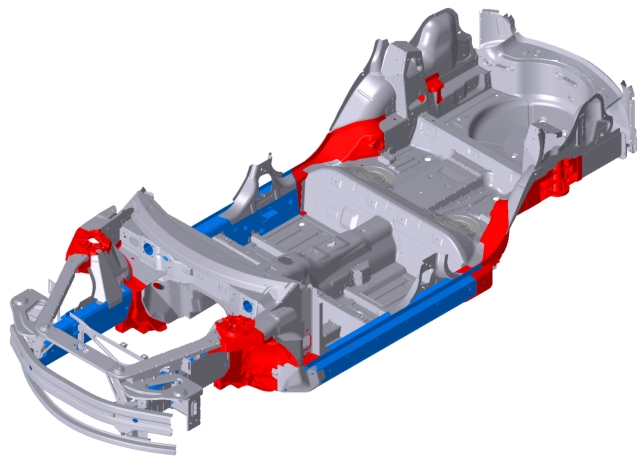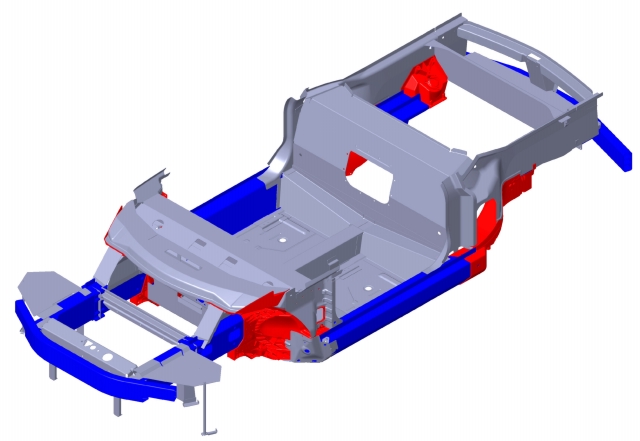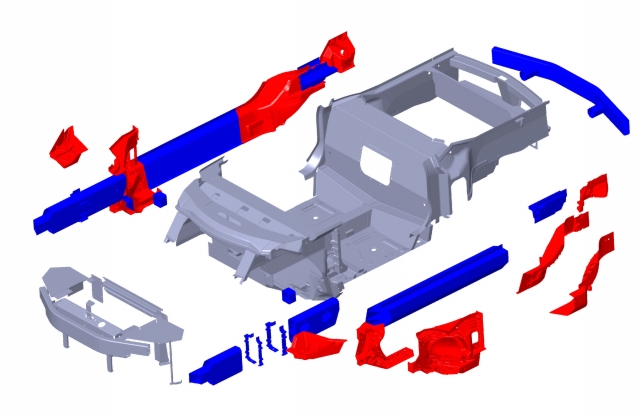Golden Gate Lotus Club
Lotus VVA Chassis Technology
Lotus Engineering reveals understructure of its innovative Versatile Vehicle Architecture (VVA).
Lotus Engineering, the leading automotive engineering consultancy, is revealing a stunning example of its revolutionary
Versatile Vehicle Architecture (VVA) at the 75th Geneva International Motor Show.
Constructed almost entirely from aluminium subcomponents, the understructure reveals the next stage in the development
of the innovative technology. The structure reveals the high-pressure die cast corner nodes that are key to an architecture
that additionally draws upon Lotus' extensive experience with bonding and extruded aluminium.
"I'm very pleased to be able to demonstrate how far we've come with VVA," explains Steve Swift, head of vehicle
engineering. "The understructure proves the concept and we're excited about the possibilities the technology brings to
OEMs worldwide."
"We expect that the demonstration of this technology through a real understructure will stimulate yet more interest
from OEMs or consortiums looking to produce exciting products utilising cost efficient, proven architecture," he adds.
Versatile Vehicle Architecture
Lotus Versatile Vehicle Architecture (VVA) has been developed to bridge a gap in the investment-volume curve to exploit
the benefits of producing at medium volumes but for niche markets, thereby giving the best chance of business case success
and favourable returns.
VVA exploits Lotus Engineering's expertise in aluminium, steel and composite body engineering, joining techniques, and
vehicle systems integration. This innovative technology offers a fast-to-market, cost-effective approach to differentiated
niche products by spreading the development, investment and bill of materials burden across a range of niche vehicle variants,
without the compromise that stems from conventional 'platform sharing'.
The philosophy is based on the commonality and versatility of key elements of the vehicle structure and body systems across
a 'family' of niche vehicle variants, with a combined annual production rate of up to around 50,000 units. Structural
components common to each family member are arranged in different configurations in each variant around the ingenious corner nodes.
The great advantage of this technology is that it can be used by one OEM looking to develop a range of niche products, or by
a group of OEMs looking to share investment, but still retain a high degree of end product separation.
"We believe it is a technology that provides solutions to a wide range of manufacturers," says Swift. "The worldwide
vehicle market continues to sub-segment at a rate greater than its overall growth, leading to lower volumes per vehicle variant.
OEMs are looking for architectures that give them a superior investment return with a high degree of product separation. VVA
gives them that opportunity"
Understructure Construction
The self-piercing rivets are used in a similar way to spot welding on a conventional steel shell, with the flow-drill screws
used for single-sided access on closed sections. Both suffice to hold the structure together during the bonding cure cycle,
and prevent adhesive joint peeling in the event of a crash.
The heat-cured high strength structural adhesive is the main joining medium, and used in combination with the mechanical
fasteners, produces an immensely strong, durable joint and a lightweight shell with exceptional torsional stiffness.
Lotus Cars Product
Example VVA families
Family A
Family B
Family C
Continuing to Change the Rules of Niche Vehicle Development
February 23, 2005
Traditionally OEMs seeking to gain competitive advantage through exciting niche vehicles have to either design a new
platform or share one already available. Engineering a bespoke low-volume platform is an expensive, time-consuming solution,
whilst sharing a mainstream chassis normally results in compromises in performance and design.
The understructure is aluminium riv-bonded, consisting of high-pressure die-castings, stampings and extrusions, and uses
advanced assembly techniques, including adhesive bonding, self-piercing rivets and flow-drill screws for construction.
VVA is the technology that will be used by Lotus Cars for a forthcoming range of sportscars. The understructure exhibits
the principles by which Lotus will engineer its own product
The following represents illustrative VVA families that could be achieved:



